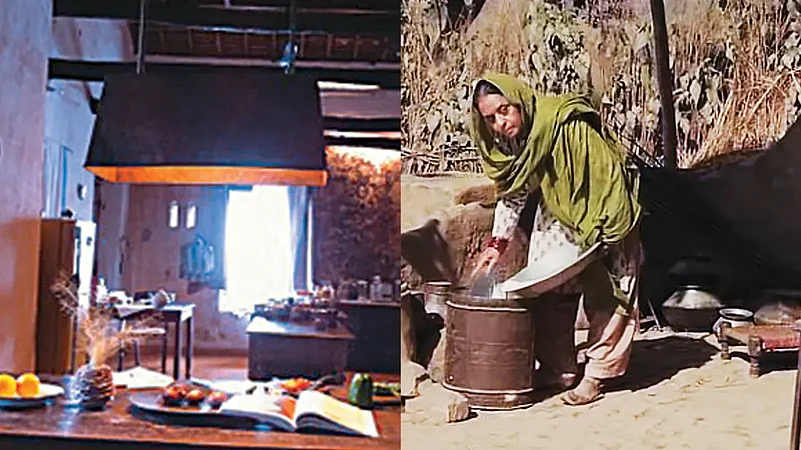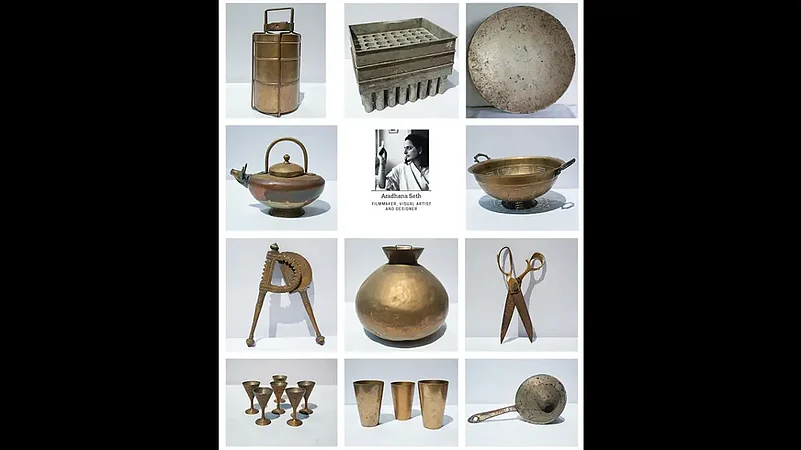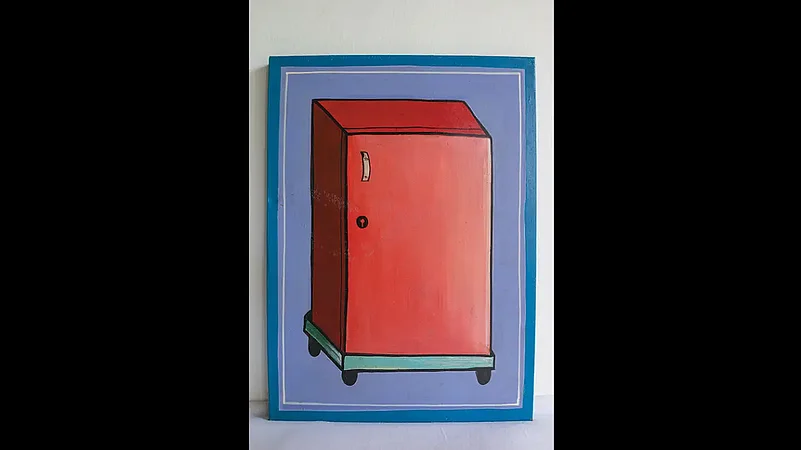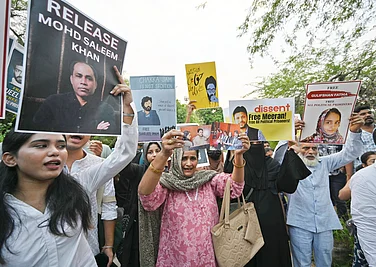For Aradhana Seth, food is both an inventive and revealing way to explore a character’s narrative arc. The filmmaker, production designer, visual artist and producer is a prolific storyteller with an ability to effortlessly plug into different cultures across her Indian and international projects—she was art director for Wes Anderson’s 'The Darjeeling Limited' (2007) and producer for Netflix series 'A Suitable Boy' (2020)—loves using food to tell a story. Seth’s interpretation of the intersection of food and cinema over the years has utilised Indian kitchens, and all the objects and rituals associated with them, as a means of shaping a particular kind of onscreen semiotics. From flying down specially cooked suckling pigs at Imperial Hotel in New Delhi, to ordering silver thalis from the royal kitchen at Umaid Bhawan, to sourcing almost 200 food platters from countless vendors across Jodhpur… it was all Seth’s doing to pull off a big, fat authentic feast for the American period epic One Night With The King (2006). “If you are what you eat, then who gets to eat what, and how?”, she asks, explaining how each and every detail of who gets haldi with their milk, who gets the badaam, or whether a lota is being used by someone to serve water or hold flowers is planned out to the T.
Kitchens become a way of ascribing personality to faces and places. They can be a space for both casual and cathartic conversations, where conflict and confessions play out, where familiar hierarchies are drawn or where bread is broken and bonds are forged. For women, they can be equally oppressive or meditative spaces, where they can be trapped in the mundane or revel in the therapeutic nature of predictability and repetitiveness.

On this thought, Seth creates stark contrasts of two worlds across Pakistan and England in West is West (2010). The materiality of Basheera’s (Ila Arun) open-air kitchen is all handmade, the lakdi ka chulha, earthen rustic rasoi, all replete with dust, fresh air, and no electricity. Her kitchen is the space where she soldiers on with her every day, but also experiences longing and separation from her husband, George (Om Puri), away in England running his own kitchen—a fish and chips shop where his labour is paid for unlike Basheera’s. She channels her missing into small delicate artworks, such as the embroidered green sequinned teapot which reminds her of all the mornings they spent together. This work of love ends up adorning the walls of her bedroom, where Ella (Linda Basset)—George’s new English lover whose own home full of porcelain cups and saucers is the diametric opposite of Basheera’s chalky enamel plates—stays when she comes to visit Pakistan. The design for Basheera’s home was inspired by pictures of the childhood home of Ayub Khan Din, the British actor and West is West writer.
ALSO READ: Beef In The Land Of Humans

Seth’s practice is full of such thoughtful details, visual research mixed with characteristic objects and artworks she might design or commission herself. As an artist, she has exhibited at Grosvenor Gallery, London, Vadehra Art Gallery, Bornemisza Art Contemporary in Vienna, Khoj, New Delhi, and Chemould Prescott Road, Mumbai, among others. Away from West is West’s rural Pakistan of the 70s, is Seth’s Earth (1998), set in the Lahore of 1947, featuring Aamir Khan as the ice candy man who uses his kitchen to fill up his brass tiffin, and the popsicles he sells in a beautifully designed metal tray. Unlike women relegated to their homes, his mobile kitchen affords him movement across urban corners of Lahore, where he sells, and soaks up public spaces such as Victoria Park, which was actually recreated in Delhi’s Lodhi Garden.
In her book, Yearning: Race, Gender and Cultural Politics, the American feminist academic bell hooks wrote about how her memories of women cooking at home were not synonymous with oppression or drudgery, but instead with creativity, nurturance and sharing. We get a glimpse of this in Fire (1996), where this version of the kitchen by Seth not only serves as the space where women of the house prepare meals for the family-owned dhaba downstairs, but also where the homoerotic affair between Shabana Azmi and Nandita Das blossoms. It becomes their sanctuary away from the gaze of their apathetic husbands, they can be free and play with elaichi pods, feed one another and smell each other’s mouths. Seth designed the space with maroons, yellows and burgundies to create warmth and intimacy. Ironically, the space then doubles up to be the fiery backdrop to where Azmi is set ablaze, with her husband passively looking on.
ALSO READ: Food Apartheid: Non-vegetarians Not Allowed!

Cut to Angry Indian Goddesses (2015), the film centred on a group of eclectic women who come together for a holiday in Goa, pairing drinks with most meals, mulling over career updates and life choices. In this world, the kitchens reflect cosmopolitan aspirations and lifestyles—food is about pleasure, cooking is recreational, and boring meals are cooked by the house help. We see tomatoes being sliced and seasoned for pasta, next to Indian celebrity chef Ritu Dalmia’s cookbook, Diva Green. A pop-art painting of a toaster created by Seth serves as a backdrop to conversations about the perils of consuming bread and gluten.
ALSO READ: What Ignites Hatred In The Belly?
Then there is an India that is more self-aware of its aesthetic prowess, seen in instances such as the custom hand painted ceramic plates for Wes Anderson’s picture-perfect train diner in The Darjeeling Limited (2007). Between the floral upholstery fabric sourced from Jaipur textile giant Anokhi, the sharp Indian uniforms of the train staff, and the spectacular miniature paintings created on the ceilings of the train that was modelled after the famous Orient Express, there’s a recognition that you eat with your eyes, beyond what’s on your plate. Even on the decadent menu created to match up to this special train, you find a simple yet classic tomato soup that’s synonymous with Indian train journeys. Seth’s own favourite food film, Eat Drink Man Woman (1994) by Ang Lee, is a culinary spectacle that heroes Chinese cooking. But even when food is not the focus, it is a powerful vehicle for storytelling. There is always some paan being chewed, chai being sipped on, or dinner being served, and Indian cinema knows how to mirror that.
ALSO READ: Caste On A Platter: Food For Dalits

Showcasing the way people eat can say volumes about the evolution of their characters, whether how Farhan Akhtar’s leafy London salads in Sky is Pink (2019) are contrasted with the greasier North-Indian meals of his character’s Old Delhi upbringing, or Don’s (2006) suave suppers at the Four Seasons in Langkawi compared to the tiny chawl kitchen in Mumbai, he used to muster up meals as Vijay. “It becomes a subliminal way to understand a story. The very specific details of eating tomato soup, kebabs, biryani, or Italian food all add to an understanding of something that’s universal, or that of the ‘other’,” says Akhtar. Watching a film, at the end of the day, is not only a sensorial but also a human experience, with each moment holding its own sense of purpose, pleasure, and pathos.
(Views expressed are personal)
ALSO READ
Fiza Ranalvi Jha Goa-based Culture writer and design researcher





















